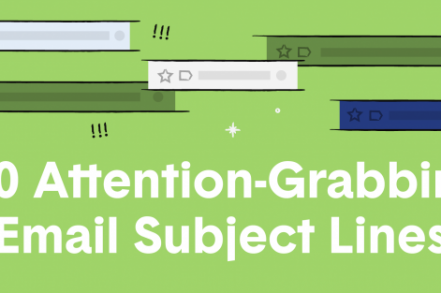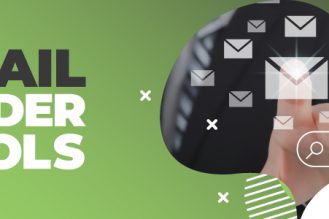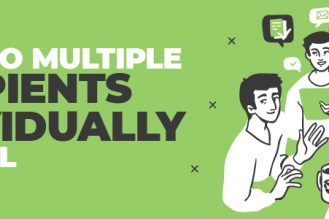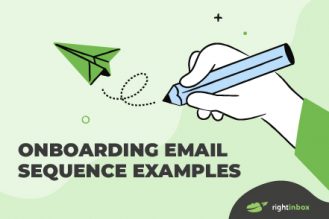You know what they say: You never get a second chance at a first impression.
If you’ve been tracking your email open rates and have noticed that your open or click-through rates are not as high as you want them to be, your subject lines may be to blame.
Subject lines are the first part of an email that a reader sees. If that small line of text isn’t engaging, exciting, or attention-grabbing, there’s a strong chance your email won’t be read—or even noticed.
Luckily, we can help. Take a look at our list of 100 attention-grabbing subject lines to learn how you can give your emails a competitive edge.
Email Subject Line Best Practices
While there are plenty of formulas you could follow to write an effective email subject line, some of the most attention-grabbing lines are the ones that break the mold and are more unconventional.
However, even when you’re being creative, there are some basic guidelines to follow to ensure your subject line is still effective. From grammar basics to messaging style, here are some best practices to keep in mind before writing a perfect attention-grabbing subject line.
Use Short Lines
Subject lines are intended to be short previews of an email’s contents. That means that there is a limit to how much text can be displayed.
The ideal length of a subject line is approximately 40-60 characters, or 7-10 words. You should be able to adequately convey your message within that limited space.
Consider Capitalization
Email subject line capitalization is one of many grammatical characteristics that define your brand’s voice and tone. Lines written in title case may appear more traditional to some recipients, and may make your brand look more official and authoritative. On the other hand, sentence case subject lines may be perceived as more casual and informal to readers, and may paint your brand as more personable and less spammy.
Give Yourself Options
When it comes to creative writing, no one knocks it out of the park on the first try. Draft two or three different versions of your subject line to find the right fit for your audience. Having extra versions also gives you the ability to test what actually resonates when you have the opportunity.
Explore Punctuation Carefully
Punctuation is key in conveying exactly the right message. And though it may be tempting to use every writing hack you have to fit your message in the limited line space, punctuation should be approached with caution.
Excessive use of punctuation like exclamation points, hyphens, or repeated question marks or periods can come off as ambiguous and therefore spammy. This may lower the chances of your email being opened.
According to Mailchimp, subject lines should contain three punctuation marks max. Anything more may make your sentence too complex to understand quickly.
Be Aware of Emojis
Using emojis is a great way to get your email noticed in an inbox filled with plain text. They can be used to add personality to your brand and help support messaging.
However, surveys have shown that some professionals — specifically those who are older — still consider using emojis as inappropriate for professional emails. This suggests that if you want your email to be perceived seriously, consider whether or not your audience is receptive to emojis in the context in which you would like to use them.
Be Actionable
It goes without saying that the purpose of an email is to be opened. However, if a reader doesn’t believe the email has value, they are likely going to skip over it.
Using actionable words or phrases in subject lines is an excellent way to describe what can be accomplished if an email is opened. For example, “Learn more about..” suggests the email contains information, and “Save big on…” suggests the email contains a discount or info on a sale. These phrases both inform recipients what the email contains while also encouraging them to take action.
Ask Questions
Asking a question in your subject line is one of the most effective ways to spark a reader’s interest. If a question catches their eye and they want to learn more, they’ll be more inclined to open the email in search of the answer.
Use Urgency
FOMO, or “fear of missing out,” is a psychological principle that can be used to prompt a sense of urgency in your subject lines. Using phrases that suggest an element of scarcity will trigger a response from readers who may be worried that they could miss their window of opportunity.
Write in Second Person
To engage with your readers, write using second-person pronouns such as you, your, yours, yourself, and yourselves.
Email recipients are more likely to engage with content that resonates with them personally. Addressing them in second person immediately connects your message to the reader, encouraging them to feel more invested in the message within the email.
Understand Your Audience
The most effective way to share your message is to understand who you’re speaking to. This includes knowing several key facts about who that person is, such as:
- Their demographic information
- Their needs
- Their pain points
- Their day-to-day experiences
This background information will provide insight into the topics they may be interested in, the way they expect to interact with brands, and the language that may resonate with them the most.
Focus on One Topic
While there is some debate on the right length of an email, there is no debate about a subject line’s character limit. Make the most of this space by focusing on one topic that covers the key point (or points) of the email’s contents.
Use Your Inbox for Inspiration
Can’t think of what to say? Chances are there’s an email in your inbox similar to the email you’re trying to compose.
Use emails you’ve opened — which were clearly successful — as jumping-off points to start your brainstorm session. Then, tailor your subject line to fit the needs of your audience and the content of your email.
Use Personalization
Email recipients are more likely to engage with an email if they feel personally connected to a message. In fact, emails that include personalized subject lines or personal information that is unique to the receiver are more likely to be opened than emails that do not.
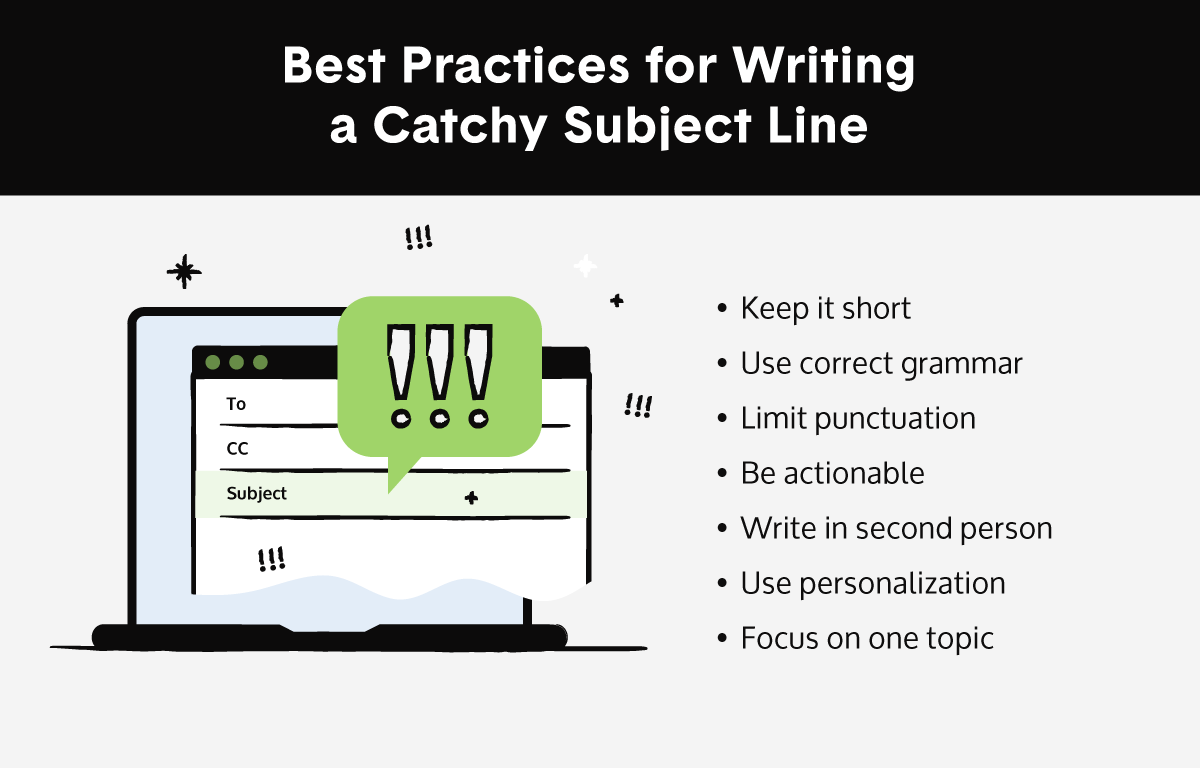
100 Attention-grabbing Marketing Subject Lines in Emails
Subject lines that catch the eye of one recipient may not always grab the attention of another. This may be due to each individual reader’s response to the voice, tone, and messaging style the subject line is written with.
Another element to keep in mind when you’re crafting an eye-catching subject line is the purpose of the email. For example, an email invoice with a humorous subject line may be passed over by a recipient who assumes joke subject lines are all spam.
In order to write a subject line that will grab your readers’ attention, you must first determine the writing style each subject line should be written in and what emails they each work best with. Here are some examples of the most common styles of attention-grabbing subject lines.
Informative Email Subject Lines
The purpose of an informative subject line is to educate the reader on a piece of information, often included in the contents of the email. These subject lines are straightforward, direct, and provide value to the reader from the beginning.
- Hey, [Name], you have 54 unread messages!
- New job opening: [Job Title]
- Request for [Event] approval has been received
- Lunch & Learn this [Day of the Week]
- Attention: Our hours are changing
- Best places to visit in [City Name]
- The Best Of [Topic]
- What every [Job Title] should know about [product or job]
Humorous Email Subject Lines
Funny subject lines are written in a way that both grab attention and lift the recipient’s mood. These lines may include puns, jokes, or plays on words intended to make the reader smile.
- Our news is too BIG for this subject li–
- Awwww-inspiring ideas for Valentine’s Day
- Knock-knock! Who’s there?
- Don’t tell my supervisor
- Hey, did you forget to open this?
- Revised policy regarding [Absurd Situation]
- O-M-[Word That Starts With G]
Urgent Email Subject Lines
Subject lines written with a sense of urgency typically focus their message on highlighting a limited amount of resources, such as time, product, or general opportunities. They work to promote a sense of unease that encourages readers to take action.
- Reminder: Deadline for [Task] is approaching
- Data notice from [Business Name]: You’re over your limit
- There’s Still Time To Save On These Exclusives
- Just a couple left…
- Register for the [Event Name] before they seat go
- Your trial ends soon. Upgrade your plan now
- Seats are going fast—get yours before it’s too late
- Your account will be deactivated in 30 days
- There’s still time!
Question Email Subject Lines
Question subject lines are often used to ask the recipient a direct question, causing them to stop and think. These questions are typically framed in a way that suggests the answers can be found within the email itself.
- Quick question: Have you seen our new [Product]?
- Are you covered this holiday season?
- How can you [Topic]?
- Why did the chicken cross the road?
- Where do you go from here?
- Tired of [Action]?
- Did you find what you were looking for?
- What can you afford?
- What do you think?
Promotional Subject Lines
Promotional subject lines are often used for retail-focused emails containing information about a sale, discount, or promotional event. Although these subject lines often compete with more spammy competitors, properly planned and personalized promotional subject lines can be effective and informative.
- Special offer for [Company/Product]
- Offer extended: $200 off [Brand] Plus
- Save money. Don’t leave the couch.
- Mystery Savings Have Arrived
- Try [product] for 1 week for free
- FREE 2X upgrade on your first order!
- Get the max, guaranteed! Exclusive offer inside.
Benefit-focused Email Subject Lines
Subject lines that are benefit-focused shape their messaging around the value the email body copy will provide the reader once they read it. These lines are positive, promising, and typically highlight a product or brand’s value propositions.
- How is it going at [Business Name]?
- [Name], treat yourself with an upgrade
- How [name of group] grew their from 0-10
- [Name], meet your new favorite [Feature or Product]
- Enjoy [benefit] right at your fingertips
- Treat yourself
- The secret to protecting your IRA/401(k)
- Earn points and win big
- The getaway you’ve been waiting for
Pain Point-oriented Email Subject Lines
Subject lines that are focused on pain points aim to promote a feeling of unease or discomfort. They serve to remind readers that a problem exists, but also suggests that there may be a solution to that problem.
- Overworked Student Conquers Work In Minutes
- [X] top tips for [pain point]
- Finally, [A Solution to Pain Point]
- How to fix [Pain Point] in 3 easy steps
- Still struggling with [Pain Point]? We can help
- Reduce your debt in 2 easy steps
- Too tired? We got you covered.
- Get more [Benefit] with [Product]
Introduction and Welcome Email Subject Lines
Subject lines for introduction and welcome emails can be friendly, informational, or questioning. Use these emails if you’ve never met the recipient before or you’re being introduced and may be looking to request information or assistance.
- Congratulations on your new position!
- Welcome to the team, [Name]!
- Thanks for signing up. Let’s get started.
- Welcome to [product name]—ready to [next steps]?
- I found you through [Name]
- Nice to meet you at [Event]!
- Announcing the arrival of [Name of Person or Product]!
- Meet [Name]!
Cold Email Subject Lines
Cold emails are unsolicited, initial messages intended to connect the sender to the receiver in order to begin a transactional relationship. They are professional, informational, and may be benefit- or pain point-focused.
- I’m interested in you for my [Role] position…
- You’re invited!
- Enjoyed your [Work] at the [Event] meeting last week
- Looking for a better way to [Action]? Let’s talk!
- Let me introduce myself
- [POLL] Can you answer this?
- RE: Nice to meet you
Thank You Email Subject Lines
Thank you emails are messages sent to a recipient who has completed an interaction with the sender or the sender’s brand. When considering what to put in the subject line of a thank you email, keep it courteous, friendly, and action-oriented to help keep the reader engaged.
- Thank you for visiting us! What’s next?
- Thank you for your business
- Tell us how we did on your recent visit!
- Thanks for meeting today! Here’s a recap
- Thanks for downloading—here’s your [Title of Download]
- Thanks for helping us!
Networking Email Subject Lines
Networking emails are messages sent to new or existing professionals in order to begin or nurture a relationship. These are often sent with no transactional intent, and serve as friendly, funny, or informative ways to connect and share.
- Nice meeting you, [Name]
- [Mutual contact] recommended I get in touch
- Can I buy you a coffee?
- The five ways [Recipient’s Business] can work with [Sender’s Company]
- I saw this [Resource Type] and thought you’d enjoy it
- [Greetings], [Name]
- Reaching out to say hello!
Meeting Request Email Subject Lines
Emails sent to request meetings are straightforward and have one intention: to schedule a meeting between two or more people. They can be formal, funny, or urgent based on the context and needs of the meeting. Here are some examples of a meeting request subject line.
- Invitation to attend [Event Name]
- Are we still on for [Date and Time]?
- Hi [Name], I’d love to chat
- Time for a quick chat?
- Our next steps
- You are invited!
- 15 minutes: [Date]?
- Please join us for a meeting at [location and date]
Reengagement Email Subject Lines
Reengagement emails are emails sent to potential customers or clients who have interacted with a brand or company once, but not in a significant amount of time. These emails can be informative, urgent, or funny ways to remind the reader about the brand and encourage them to continue their interactions.
- We love you. We miss you. Come back.
- You have 3 items in your cart
- Give us another chance?
- We’ve made some improvements since you’ve been away
- Pick up right where you left off
- It’s been a while… Here’s a discount code [Code]
- The price dropped on items in your cart
Get Your Emails the Attention They Deserve
With approximately 340 billion emails sent and received a day globally, competition for that attention in the inbox is stiff. However, following these examples of attention-grabbing subject lines can give your email the edge it needs to be seen.
Not sure if your subject line is working? Monitor your email’s success with an email tracking extension to learn how well it’s performing. This data will help you pinpoint exactly how to grab your audience’s attention and improve your emails’ success.
Track emails, email reminders & templates in Gmail for free
Upgrade Gmail with the features it’s missing
Add to GmailDavid Campbell
David Campbell is the editor of the Right Inbox blog. He is passionate about email productivity and getting more done in less time.
